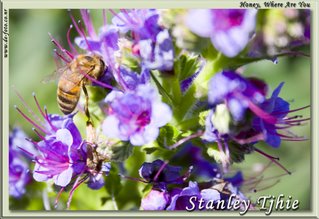
Honey is a sweet and viscous fluid produced by honeybees from the nectar of flowers. "The definition of honey stipulates a pure product that does not allow for the addition of any other substance.
Honey is significantly sweeter than table sugar and has attractive chemical properties for baking. Honey has a distinctive flavor which leads some people to prefer it over sugar and other sweeteners.
Liquid honey does not spoil. Because of its high sugar concentration, it kills most bacteria by plasmolysis. Natural airborne yeasts cannot become active in it because the moisture content is too low. Natural, raw honey varies from 14% to 18% moisture content. As long as the moisture content remains under 18%, virtually no organism can successfully multiply to significant amounts in honey, though, importantly, enough bacteria survive to make honey dangerous for infants.
Honey is a mixture of sugars and other compounds. The specific composition of any batch of honey will depend largely on the mix of flowers consumed by the bees that produced the honey. Honey has a density of about 1500 kg/m3 (50% denser than water), which means about 12.5 pounds per US gallon.
- Typical honey analysis
Blended
Most commercially available honey is blended, meaning that it is a combination of honeys from different sources. China is the world's largest producer of honey (256,000 tonnes in 2001), followed by the United States (100,000 tonnes), Argentina (90,000 tonnes), Turkey (71,000 tonnes), Mexico, Ukraine and India
Comb honey A popular honey product. The honey is sold still in the wax comb. Comb honey was once packaged by installing wooden framework in special supers, but this labor intensive method is dying, and being replaced by plastic rings or cartridges. After removal from the hive, a clear cover is usually fitted onto the cartridge so customers can see the product.
Honey is not always edible. Because it is gathered from flowers in the wild, there are situations in which it may be toxic.
There are several types of honey that are known to be toxic to humans. The most common of these in the northern hemisphere, popularly known as Mad Honey, is produced from the flowers of rhododendrons, mountain laurels and azaleas. The nectar of these plants may contain grayanotoxin, a compound which is both psychoactive and poisonous to humans but harmless to bees. The effects of Mad Honey have been reported in Western literature as early as 401 BC (see Xenophon's description of the effects of toxic honey in the Anabasis). The shape of the azalea flower, however, makes access to nectar difficult for honeybees. Furthermore, during the time when azaleas bloom, there are usually other flowers available that are more appealing to the honeybee. Thus, lethal honey is rarely encountered. Mad Honey is also sometimes called Green Honey, Crazy Honey or Meli Chloron (ancient greek).
(courtesy wikipedia.com)




4 comments:
Hrmmmmmmm i like the details of the pic.... but abit too bright =)
Oh.. okay. abit overexposed huh.. have to tone it down abit
the title remind me of drama scene 2
Honey where are you? - jolyn
Then u come out over exposed as well
Haha.. very over exposed huh. haha. wearing singlet some more. haha
Post a Comment